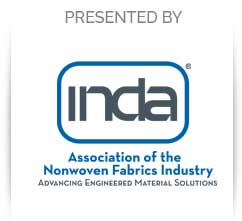Conference Speakers

Pallabi Sinha Roy
Process Engineer,
Process Engineer, having 3.2 years of experience in Polymer-extrusion based Nonwoven Production Technology – “Reicofil 4s”, also having Plant Start-up & Commissioning experience and was associated with all the initial International Customer Audit & Product Qualification Process.An M.Tech in Fibres & Textile Processing Technology from NAAC provided A++ grade college ICT, Mumbai and also having a Certification in “Statistical Process Control” from ISI, Mumbai.
Currently, I am not associated with any organization, pursuing MBA in correspondence and also preparing to take admission in doctoral studies.
Thursday 9:00 am - 9:30 am
Web Formation Technology
Novel Method to Determine Nonwoven Uniformity Factor
Uniformity of a Spunbond or Spunmelt Nonwoven fabric is a critical factor in determining the quality and properties of the fabric, as well as impacting the performance of the end product. However, uniformity is not being measured or tracked in typical nonwoven productions as an ongoing, high frequency quality metric. Vision systems focus on defects and not an overall uniformity metric or a trend during production runs. Several off-line uniformity methodologies have been reported in literature (typical via imaging and image analyses), but they require additional investments, training and ongoing maintenance. The methodology proposed here is easy, ongoing such as other quality lab metrics, and does not require additional investments. A universally known and applied lab method is basis weight distribution across the web and over time it can provide a fair idea about the fabric uniformity on a sample of 100 to 1000 cm2. Yet in many cases, it is difficult to differentiate slight variations in the uniformity of the fabric. The proposed method can determine uniformity of nonwoven fabric in percentage (0 to 100%), it utilizes existing lab measurements, and has no need for additional equipment except a computer where the frequently sampled quality metrics can be combined for statistical calculations. During the development of this new Non-Woven Uniformity factor (NWUf) methodology several properties and test methods have been evaluated for their suitability to determine uniformity of the nonwoven in production. The approach is split into two stages. Firstly, we measure and utilize properties of the nonwoven fabric which are regularly measured and are influenced by the "process recipe" and uniformity or the structure of the fabric during a production run. These are basis weight, air permeability and opacity -e.g. basis weight (with standard test methods by EDANA) alone fails to provide sufficient information about the uniformity. These three variables turned out to be very suitable to determine uniformity using statistical methods in the second stage. If statistical variation and spread are zero, then the fabric would have 100% uniformity, which practically is not possible for nonwovens due to the random laydown (except for extremely high basis weights). The result is a percentage value representing the uniformity on a scale of 0 to 100 %.




